Two new awards will help the University of Rochester prepare a more diverse pipeline of optics professionals.
Two recent awards will enable the Institute of Optics at the University of Rochester to help address a pressing need for highly trained PhD graduates, including women and underrepresented minorities, in industry, research labs, and academia.
A $900,000 GAANN (Graduate Assistance in Areas of National Need) grant from the US Department of Education will pay for six PhD fellowships, at least half of which will be awarded to students from underrepresented groups.
Apply for optics PhD fellowships
Email Kat Davies, graduate coordinator for the Institute of Optics, to learn more.
Another $500,000, to be matched by the University, comes from SPIE, the international society of optics and photonics. The SPIE Endowment Matching Program award will initially provide stipend and travel support for an additional student but is expected to grow.
Founded in 1929, the institute is the oldest optics degree-granting program in the nation. To date, it has granted approximately 2,800 degrees—about half of all optics degrees awarded in the US. The institute currently enrolls 102 PhD students.
“Rochester has a long history of successful optics education, and many of today’s leading optics researchers have emerged from its Institute of Optics. This endowed fund is a critical partnership between SPIE and the University of Rochester, one that will help ensure that pipeline of leaders continues for generations to come,” says SPIE president Anita Mahadevan-Jansen.
‘Tremendous momentum’ in optics PhD recruiting
“One of the most important aspects of a gift like this,” says Thomas Brown, interim institute director and professor of optics, “is that it allows us to ‘invest in the best,’ to continue searching for future Nobel laureates, entrepreneurs, and engineers from all over the world to come to Rochester and be part of our growing family.”
In 2018, Donna Strickland ’89 (PhD) was awarded a Nobel Prize for work she did at the University’s Laboratory for Laser Energetics as an optics PhD. Strickland is only the third woman to receive the prize in physics—and her accomplishment was a “watershed moment for our PhD program,” Brown says. “It imparted tremendous momentum in our recruiting.”
“The present employment prospects for optics PhD graduates are excellent, because they are recruited from such a broad range of industries, universities, and government laboratories,” Brown says. “The requests we receive from prospective employers hungering for fresh PhD students continue at a steady pace. All our recent graduates have found employment before or within a month of graduation, and PhD graduates who are US citizens or permanent residents are in particular demand.”
Many of the institute’s graduates find employment in the Rochester region, a hub of more than 90 optics-related companies. AIM Photonics, which designs and manufactures complex photonic integrated circuits, and entrepreneurial initiatives such as Luminate, which provides startup funding for optics-related initiatives, have cemented Rochester’s international reputation in the field.
Collaboration in the classroom and the lab
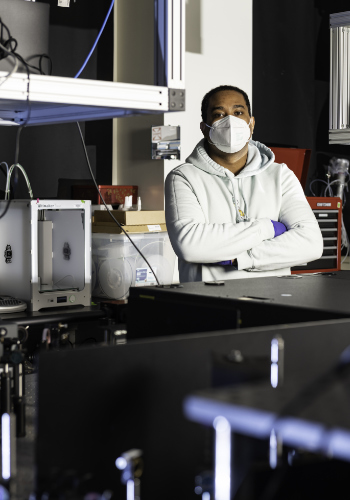
With its four-to-one ratio of PhD students to faculty, the institute prides itself on fostering a close-knit community. It does so through open-door access to faculty, weekly informal gatherings, as well as annual departmental picnics, holidays parties, and family-friendly events. Despite recent necessary curtailments due to COVID, two current PhD students say they’ve benefited from the collegial atmosphere.
“I feel like I’m part of a unique community at the institute,” says Katie Dunn. “When you’re taking first-year classes and studying for preliminary exams, it’s not a competitive environment. Everyone is trying to help each other out.”
Fellow optics PhD student Kareem Garriga concurs and adds, “We have a very collaborative environment, with access to cutting-edge technology,” he says. “The facilities afforded to us and the freedom we have as graduate students allow us to tackle problems and delve deeper in all subfields, from quantum optics to laser fusion.”
Garriga, for example, is researching terahertz electromagnetic waves in the lab of Xi-Cheng Zhang, a leading expert in field. The waves are hard to detect, but could have interesting applications, for example in detecting drugs or explosives behind barriers, which is why Garriga is working to create a detector to improve the characterization of THz sources.
Dunn, meanwhile, is a member of the research group of Andrew Berger, an expert in developing optical contrast mechanisms to analyze untreated cells and tissues. She is using a technique called angularly resolved light scattering to learn more about the organelles within single cells, which could have applications for improved medical diagnosis and treatment.
Both students say they appreciate the supportive mentoring they’ve received. Berger, for example, “really cares about his students—that they’re flourishing as researchers, and also as people,” Dunn says. “He gives us a lot of his time.” Another big supporter has been Jim Fienup, the Robert E. Hopkins Professor of Optics, who has taught several of Dunn’s favorite courses and helped her with the Fourier processing she uses as part of her research. He is on her thesis committee.
Garriga says that Zhang “has been great because he’s given me a lot of freedom to approach topics on my own accord and in my own time. I’ve also learned a lot about mentoring and grant writing from him.” Yiwen E, a research associate in the lab, has helped Garriaga develop his skills as a lab researcher and teaching mentor, he adds. “She also taught me how to keep up with the latest trends and how to always be innovating in a field that continues to move as fast as our does.”
Both say they wholeheartedly encourage aspiring optics PhD students to consider enrolling at the institute. “If you’re interested in optics, it’s definitely a wonderful place to be,” Dunn says. “You are surrounded by a lot of other students and faculty who are very interested in similar things. And everyone is on board to help you with whatever you want to learn.”
What sets us apart

Research across domains
- Computers, information processing, and data storage
- Defense and national security
- Energy
- Health and medicine
- Advanced manufacturing
- Advanced photonic measurements and applications
- Strategic materials for optics and displays
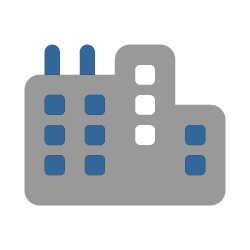
Collaborations across campus
- Laboratory for Laser Energetics
- Center for Freeform Optics
- Center for Emerging and Innovative Sciences
- Center for Visual Science
- Center for Coherence and Quantum Optics
- Flaum Eye Institute

Partnerships with industry
- Eastman Kodak (est. 1888), Bausch + Lomb (est. 1853), and Xerox (est. 1906) opened their doors in Rochester.
- Today, Rochester and the surrounding region is a research and manufacturing hub for optics, photonics, and imaging.
- At the University, 49 companies participate in the institute’s Industrial Associates training program.
By the numbers
1st
Optics education program in the nation
Est. 1929
The institute has awarded about half of all optics degrees in the US
21 Optica presidents
Alumni or current or former faculty who have led the scientific organization.
92%
PhD student retention rate
150+
Alumni and faculty have started companies
3 faculty in 5 years
Elected fellows of the National Academy of Inventors
4:1 ratio
PhD students to faculty
Read more
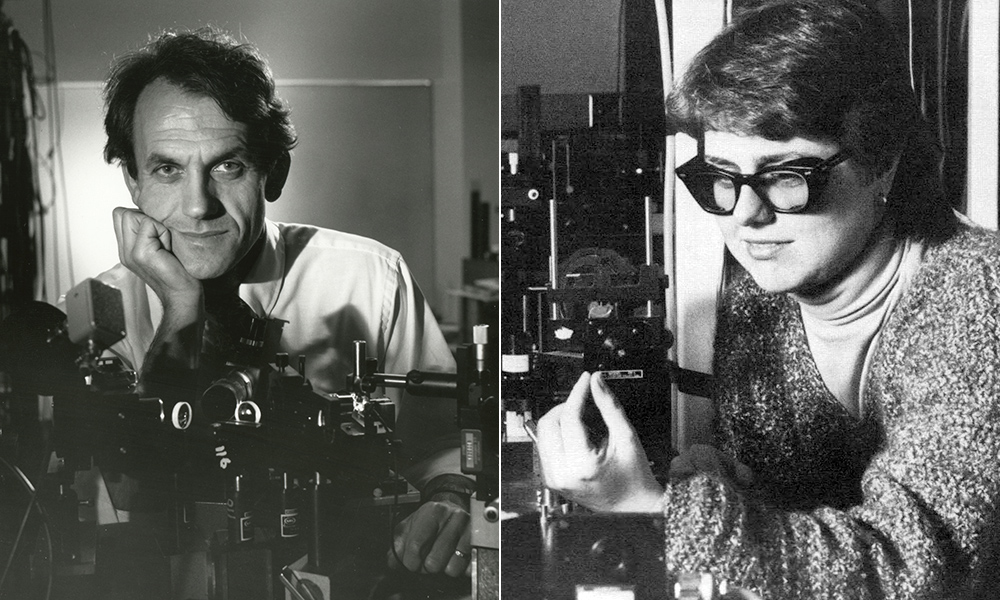 Rochester breakthrough in laser science earns Nobel Prize
Rochester breakthrough in laser science earns Nobel Prize
University of Rochester doctoral graduate Donna Strickland ’89 (PhD) and former optics faculty member Gérard Mourou shared the 2018 Nobel Prize in Physics for work they undertook at the Laboratory for Laser Energetics.
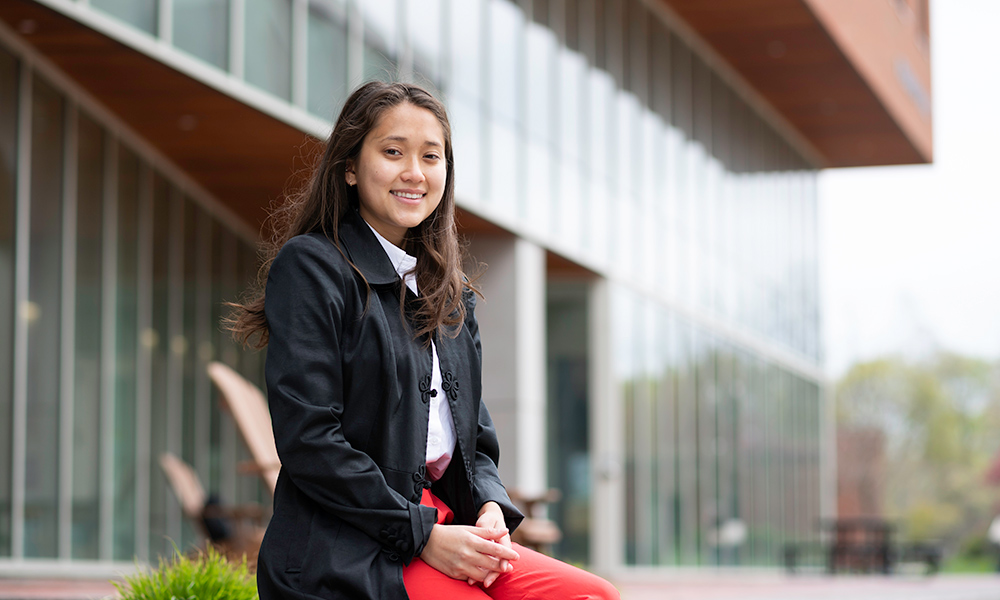 Optics grad has her eyes on the stars
Optics grad has her eyes on the stars
Optical engineer Alyssa Ho ’21 is headed to Raytheon to work on space system projects. “I found that optics was challenging me in new ways that I hadn’t been challenged before,” she says.
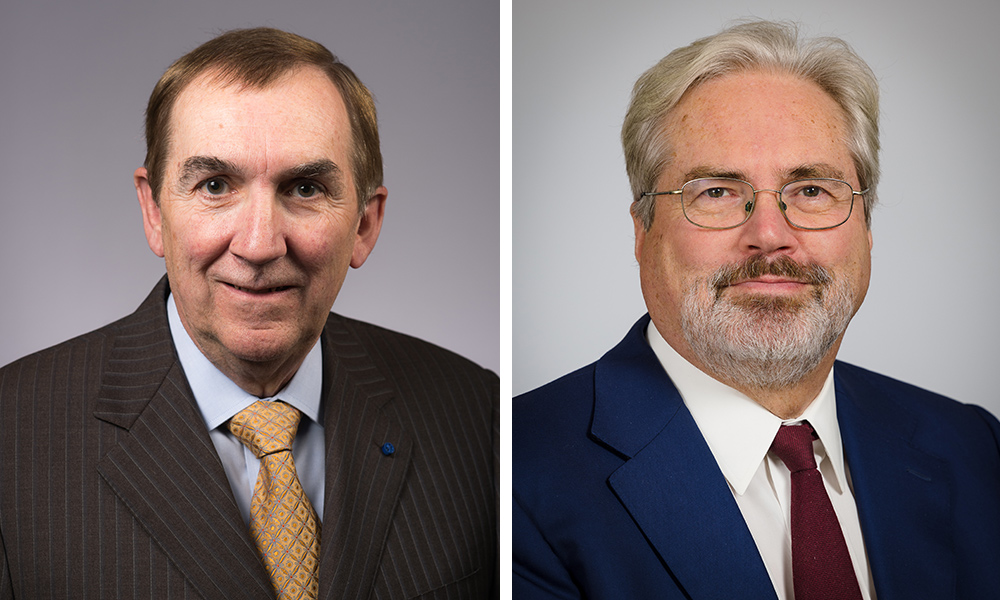 A cure for blindness? A next-generation solar concentrator?
A cure for blindness? A next-generation solar concentrator?
Two new Rochester fellows of the National Academy of Inventors take aim at transformative discoveries in the world of optics.



